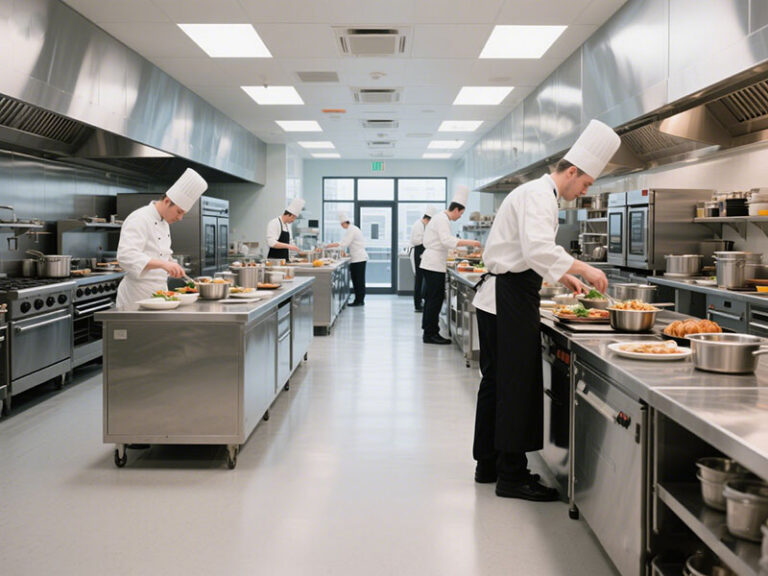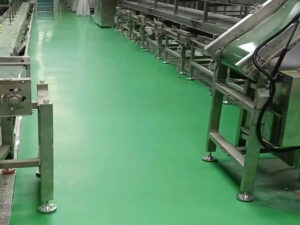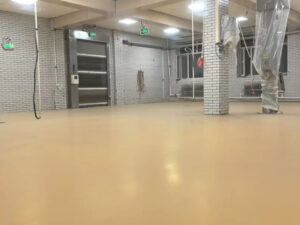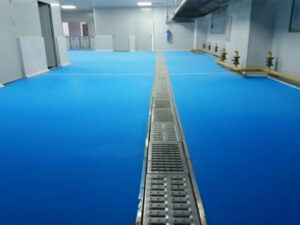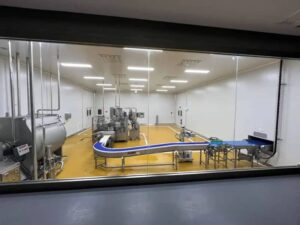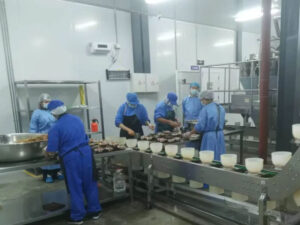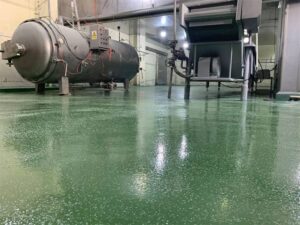مقدمة
في تشغيل المطبخ التجاري، يعد اختيار الأرضيات المناسبة قرارًا حاسمًا. تواجه المطابخ التجارية، باعتبارها المنطقة الأساسية لتجهيز الطعام والطهي، العديد من التحديات، مثل حركة المرور العالية، وانسكاب السوائل المتكررة، ودرجات الحرارة المرتفعة والمنخفضة المتعاقبة، ومعايير النظافة الصارمة. لا يمكن للأرضية المناسبة أن تضمن سلامة العاملين في المطبخ وتقلل من مخاطر الانزلاق والإصابات فحسب، بل يمكنها أيضًا تحسين مستوى النظافة في المطبخ، وتقليل احتمالية نمو البكتيريا. وعلاوةً على ذلك، يمكنها تحمل البلى اليومي، وإطالة عمر الخدمة، وتقليل تكلفة الاستبدال والإصلاح. ومع ذلك، مع وجود مجموعة واسعة من مواد الأرضيات المتوفرة في السوق، أصبح اختيار الأرضيات الأنسب للمطبخ التجاري مشكلة صعبة للعديد من أصحاب المطاعم ومديري الفنادق ومصممي المطابخ.
فهم متطلبات أرضيات المطابخ التجارية
السلامة
مقاومة الانزلاق
غالبًا ما تكون الأرضيات في المطابخ التجارية مغطاة ببقع الماء وبقع الزيت وبقايا الطعام، مما يجعلها زلقة للغاية وعرضة للتسبب في انزلاق الموظفين وسقوطهم، مما يؤدي إلى إصابات جسدية. لذلك، فإن مقاومة الانزلاق هي إحدى أهم ميزات السلامة في أرضيات المطابخ التجارية. يمكن للأرضيات المقاومة للانزلاق أن تزيد من الاحتكاك بين نعال الأحذية وسطح الأرضية، مما يقلل من خطر الانزلاق ويضمن سلامة الموظفين. على سبيل المثال، في مطابخ بعض المطاعم الكبيرة، حيث يحتاج الموظفون إلى التنقل والعمل بشكل متكرر، إذا كانت مقاومة الأرضية للانزلاق ضعيفة، فمن المحتمل أن تقع حوادث الانزلاق، مما يؤدي إلى ضرر جسدي وضغط نفسي للموظفين.
مقاومة الصدمات
غالباً ما تسقط الأشياء الثقيلة مثل الأواني والأوعية والمغارف والأحواض في المطابخ التجارية. إذا كانت مقاومة الأرضية للصدمات ضعيفة، فمن السهل أن تنبعج أو تتشقق مما يؤثر على عمر الأرضية الافتراضي وجمالياتها. لذلك، فإن مقاومة الصدمات هي أيضاً عامل مهم يجب أخذه بعين الاعتبار بالنسبة لأرضيات المطابخ التجارية. يمكن للأرضيات المقاومة للصدمات أن تتحمل تأثير الأجسام الثقيلة دون أن تتضرر بسهولة، مما يضمن سلامة الأرضية وثباتها. على سبيل المثال، في مطابخ بعض الفنادق، حيث يتم استخدام معدات وأدوات المطبخ الكبيرة الحجم، إذا كانت مقاومة الأرضية للصدمات ضعيفة، فإنها تتضرر بسهولة بسبب المعدات والأدوات، مما يؤثر على التشغيل العادي للمطبخ.
النظافة الصحية
سطح غير مسامي
المطابخ التجارية هي أماكن لتجهيز الطعام والطهي، مع معايير نظافة عالية جداً. يمكن للأرضيات ذات الأسطح غير المسامية أن تمنع البكتيريا والعفن والأوساخ من اختراق الأرضية، مما يقلل من إمكانية نمو البكتيريا ويضمن بيئة صحية للمطبخ. على سبيل المثال، في مطابخ بعض المطاعم الغربية، حيث تتم معالجة اللحوم النيئة والمأكولات البحرية، إذا كان سطح الأرضية مساميًا، فمن السهل تكاثر البكتيريا والعفن، مما يؤثر على سلامة الأغذية ونظافتها.
سهولة التنظيف
يجب تنظيف الأرضيات في المطابخ التجارية وتطهيرها بانتظام لضمان بيئة صحية للمطبخ. يمكن للأرضيات التي يسهل تنظيفها أن تقلل من صعوبة التنظيف والوقت الذي يستغرقه التنظيف، مما يحسن من كفاءة التنظيف. على سبيل المثال، في مطابخ بعض مطاعم الوجبات السريعة، نظرًا لكثرة عدد الزبائن، يجب تنظيف الأرضيات بشكل متكرر. إذا لم تكن الأرضية سهلة التنظيف، فسيؤدي ذلك إلى زيادة عبء العمل وصعوبة التنظيف على موظفي التنظيف.
المتانة
مقاومة التآكل
في المطابخ التجارية، تكون حركة الأشخاص والمعدات متكررة للغاية في المطابخ التجارية، وتتعرض الأرضيات للتآكل بسهولة. يمكن للأرضيات المقاومة للتآكل أن تتحمل التآكل على المدى الطويل ولا تتلف بسهولة، مما يطيل من عمر الأرضية. على سبيل المثال، في مطابخ بعض المطاعم الصينية، حيث يتم استخدام عدد كبير من معدات وأدوات المطبخ، تتآكل الأرضيات بشدة. إذا كانت مقاومة الأرضيات للتآكل ضعيفة، فإن الأرضيات تحتاج إلى الاستبدال بشكل متكرر، مما يزيد من تكلفة التشغيل.
مقاومة المواد الكيميائية
غالباً ما تُستخدم مواد التنظيف والمطهرات المختلفة في المطابخ التجارية، وهذه المواد الكيميائية لها تأثير تآكل معين على الأرضيات. يمكن للأرضيات المقاومة للمواد الكيميائية أن تقاوم تآكل المواد الكيميائية ولا تتلف بسهولة، مما يضمن ثبات الأرضيات وسلامتها. على سبيل المثال، في مطابخ بعض المستشفيات، حيث يتم استخدام عدد كبير من المطهرات ومواد التنظيف لضمان بيئة صحية للمطبخ، إذا كانت مقاومة الأرضيات للمواد الكيميائية ضعيفة، فإنها تتآكل بسهولة بسبب المواد الكيميائية، مما يؤثر على عمر الأرضية وسلامتها.
التكلفة - الفعالية
الاستثمار المبدئي
تختلف أسعار الأنواع المختلفة من مواد الأرضيات اختلافاً كبيراً. عند اختيار الأرضيات، يجب مراعاة التكلفة الاستثمارية الأولية. بشكل عام، تكون مواد مثل البلاط وأرضيات الإيبوكسي غير مكلفة نسبيًا، في حين أن الأرضيات المطاطية وأرضيات البولي يوريثين باهظة الثمن نسبيًا. على سبيل المثال، في مطابخ بعض المطاعم الصغيرة، بسبب قيود الميزانية، قد يختارون أرضيات البلاط ذات الأسعار المنخفضة نسبيًا.
تكلفة الصيانة على المدى الطويل
بالإضافة إلى تكلفة الاستثمار الأولية، يجب أيضاً مراعاة تكلفة صيانة الأرضيات على المدى الطويل. فبعض مواد الأرضيات تتطلب صيانة منتظمة، مثل التشميع والتلميع، مما يزيد من تكلفة الصيانة. في حين أن بعض مواد الأرضيات، مثل الأرضيات الإيبوكسي وأرضيات البولي يوريثين، لا تتطلب الكثير من الصيانة. على سبيل المثال، في مطابخ بعض الفنادق الكبيرة، حيث يجب الحفاظ على معايير النظافة العالية، قد يختارون أرضيات الإيبوكسي أو أرضيات البولي يوريثين التي لا تتطلب الكثير من الصيانة.
خيارات الأرضيات الشائعة للمطابخ التجارية
أرضيات الإيبوكسي
الوصف
أرضيات الإيبوكسي هي عبارة عن طلاء أرضيات يتكون من راتنجات الإيبوكسي ومواد مقوية. ويتميز بكونه غير ملحوم ومقاوم للتآكل ومقاوم للتآكل ومقاوم للتآكل ومقاوم للانزلاق. يمكن صياغته وفقًا للاحتياجات وسيناريوهات الاستخدام المختلفة، مثل إضافة عوامل مضادة للانزلاق وعوامل مضادة للكهرباء الساكنة لتلبية المتطلبات الوظيفية المختلفة. عملية بناء أرضيات الإيبوكسي بسيطة نسبيًا. بشكل عام، تحتاج الأرضية إلى المعالجة أولاً، ثم يتم تطبيق الطلاء التمهيدي والطبقة الوسيطة والطلاء الخفيف، وأخيراً تتم الصيانة.
المزايا
- متانة عالية: تتميز أرضيات الإيبوكسي بصلابة عالية ومقاومة للتآكل، ويمكنها تحمل قدر كبير من حركة الأقدام وحركة المعدات دون أن تتآكل أو تتلف بسهولة. على سبيل المثال، في ورش بعض المصانع، حيث يتم استخدام عدد كبير من المعدات والأدوات الميكانيكية، يمكن للأرضيات الإيبوكسية أن تتحمل بشكل جيد تأثير وتآكل هذه المعدات والأدوات.
- مقاومة جيدة للمواد الكيميائية: يمكن لأرضيات الإيبوكسي أن تقاوم تآكل المواد الكيميائية المختلفة، مثل الأحماض والقلويات والأملاح، ولا تتآكل أو تتلف بسهولة. على سبيل المثال، في أرضيات بعض المعامل، حيث يتم استخدام كواشف كيميائية وعقاقير مختلفة، يمكن لأرضيات الإيبوكسي أن تقاوم تآكل هذه المواد الكيميائية بشكل جيد.
- تصميم سلس: يمكن للتصميم السلس لأرضيات الإيبوكسي أن يمنع البكتيريا والعفن والأوساخ من اختراق الأرضية، مما يقلل من إمكانية نمو البكتيريا ويضمن بيئة صحية للمطبخ. على سبيل المثال، في مطابخ بعض مصانع تجهيز الأغذية، حيث يجب التحكم في معايير النظافة الصارمة، يمكن للتصميم السلس لأرضيات الإيبوكسي أن يلبي هذه المتطلبات بشكل جيد.
- سهلة التنظيف: سطح الأرضيات الإيبوكسي أملس وليس من السهل تلطيخه، مما يجعله مريحًا جدًا للتنظيف. تحتاج فقط إلى المسح بالماء النظيف أو بمادة تنظيف. على سبيل المثال، في مطابخ بعض المطاعم، حيث يتم التنظيف والتطهير بشكل متكرر، يمكن لخاصية سهولة تنظيف أرضيات الإيبوكسي أن تحسن كفاءة التنظيف بشكل كبير.
العيوب
- مقاومة الانزلاق غير كافية: إذا لم يتم إضافة عامل مضاد للانزلاق، فقد تكون مقاومة الانزلاق للأرضيات الإيبوكسي غير كافية، ومن السهل الانزلاق في حالة وجود بقع الماء أو بقع الزيت. على سبيل المثال، في مطابخ بعض الفنادق، حيث يحتاج الموظفون إلى التنقل والعمل بشكل متكرر في المطبخ، إذا كانت مقاومة الانزلاق للأرضيات الإيبوكسي ضعيفة، فمن المحتمل أن تقع حوادث الانزلاق.
- متطلبات البناء العالية: يتطلب بناء أرضيات الإيبوكسي موظفين ومعدات بناء محترفين. أثناء عملية البناء، يجب مراعاة عوامل مثل درجة الحرارة والرطوبة البيئية، وإلا ستتأثر جودة البناء. على سبيل المثال ، في مطابخ بعض المطاعم الصغيرة ، نظرًا لمساحة البناء المحدودة وصعوبة البناء العالية ، قد تتأثر جودة بناء أرضيات الإيبوكسي.
- صعوبة الإصلاح: إذا تعرضت أرضيات الإيبوكسي للتلف، فمن الصعب نسبيًا إصلاحها، ويجب إعادة تطبيق الطلاء التمهيدي والطبقة الوسيطة والطلاء العلوي، وهو أمر مكلف. على سبيل المثال، في مطابخ بعض مراكز التسوق الكبيرة، نظرًا للعدد الكبير من العملاء، تتلف أرضيات الإيبوكسي بسهولة. إذا لم يتم الإصلاح في الوقت المناسب، فسيؤثر ذلك على التشغيل العادي لمركز التسوق.
أرضيات من البولي يوريثين
الوصف
أرضيات البولي يوريثان عبارة عن طلاء أرضيات يتكون من راتنج البولي يوريثان ومُصلِّب. يتميز بمزايا مقاومة التآكل، ومقاومة التآكل، ومقاومة التآكل، ومقاومة الانزلاق، ومرونة جيدة. يمكن صياغته وفقًا للاحتياجات وسيناريوهات الاستخدام المختلفة، مثل إضافة عوامل مضادة للانزلاق وعوامل مضادة للكهرباء الساكنة لتلبية المتطلبات الوظيفية المختلفة. عملية بناء أرضيات البولي يوريثان بسيطة نسبيًا. بشكل عام، تحتاج الأرضية إلى المعالجة أولاً، ثم يتم تطبيق الطلاء التمهيدي والطبقة الوسيطة والطلاء الخفيف، وأخيراً تتم الصيانة.
المزايا
- مقاومة عالية للتآكل: تتميز أرضيات البولي يوريثين بصلابة عالية ومقاومة عالية للتآكل، ويمكنها تحمل قدر كبير من حركة الأقدام وحركة المعدات دون أن تتآكل أو تتلف بسهولة. على سبيل المثال، في أرضيات بعض الصالات الرياضية، حيث يحدث قدر كبير من حركة الأقدام وحركة المعدات، يمكن لأرضيات البولي يوريثين أن تتحمل هذه الضغوطات بشكل جيد دون أن تتآكل أو تتلف بسهولة.
- مقاومة جيدة للمواد الكيميائية: يمكن لأرضيات البولي يوريثين أن تقاوم تآكل المواد الكيميائية المختلفة، مثل الأحماض والقلويات والأملاح، ولا تتآكل أو تتلف بسهولة. على سبيل المثال، في ورش عمل بعض المؤسسات الكيميائية، حيث يتم استخدام الكواشف الكيميائية والأدوية المختلفة، يمكن لأرضيات البولي يوريثان أن تقاوم تآكل هذه المواد الكيميائية بشكل جيد.
- مقاومة جيدة للانزلاق: يمكن إضافة مواد مضادة للانزلاق إلى أرضيات البولي يوريثين لتحسين مقاومة الأرضية للانزلاق وتقليل خطر الانزلاق. على سبيل المثال، في ممرات بعض المستشفيات، حيث يجب ضمان سلامة المرضى والطاقم الطبي، يمكن أن تلبي مقاومة الانزلاق لأرضيات البولي يوريثين هذه المتطلبات بشكل جيد.
- مرونة جيدة: تتميز أرضيات البولي يوريثين بدرجة معينة من المرونة، والتي يمكن أن تقلل من قوة تأثير الأشخاص والمعدات على الأرض وتحسن الراحة. على سبيل المثال، في مناطق الأنشطة في بعض رياض الأطفال، حيث يجب ضمان سلامة الأطفال وراحتهم، يمكن لمرونة أرضيات البولي يوريثين أن تلبي هذه المتطلبات بشكل جيد.
العيوب
- سعر مرتفع: المواد الخام وتكلفة البناء للأرضيات المصنوعة من البولي يوريثين مرتفعة نسبيًا، وسعرها أغلى من مواد مثل الأرضيات الإيبوكسي والبلاط. على سبيل المثال، في مطابخ بعض المطاعم الصغيرة، بسبب قيود الميزانية، قد يختارون أرضيات الإيبوكسي بسعر منخفض نسبيًا.
- مقاومة ضعيفة للطقس: تكون أرضيات البولي يوريثان عرضة للاصفرار والشيخوخة تحت الأشعة فوق البنفسجية، مما يؤثر على جمالياتها وعمرها التشغيلي. على سبيل المثال، في أرضيات بعض مواقف السيارات الخارجية، وبسبب التعرض الطويل الأجل للأشعة فوق البنفسجية، فإن أرضيات البولي يوريثان عرضة للاصفرار والشيخوخة، مما يؤثر على جمالية موقف السيارات وعمره الافتراضي.
- متطلبات البناء العالية: يتطلب بناء الأرضيات المصنوعة من البولي يوريثين موظفين ومعدات بناء محترفين. أثناء عملية البناء، يجب ملاحظة عوامل مثل درجة الحرارة والرطوبة البيئية، وإلا ستتأثر جودة البناء. على سبيل المثال، في مطابخ بعض مراكز التسوق الكبيرة، نظرًا لمساحة البناء المحدودة وصعوبة البناء العالية، قد تتأثر جودة بناء أرضيات البولي يوريثين.
البلاط
الوصف
يعتبر البلاط من مواد الأرضيات التقليدية التي تتميز بمزايا مقاومة التآكل والتآكل ومقاومة التآكل ومقاومة الانزلاق وسهولة التنظيف. يمكن اختيارها وفقًا للاحتياجات وسيناريوهات الاستخدام المختلفة، مثل اختيار ألوان ونقوش وأحجام مختلفة لتلبية متطلبات الديكور المختلفة. عملية بناء البلاط بسيطة نسبيًا. بشكل عام، تحتاج الأرضية إلى المعالجة أولاً، ثم يتم وضع البلاط، وأخيراً يتم الحشو والتنظيف.
المزايا
- مقاومة عالية للتآكل: يتميز البلاط بصلابة عالية ومقاومة عالية للتآكل، ويمكنه تحمل قدر كبير من حركة الأقدام وحركة المعدات دون أن يتآكل أو يتلف بسهولة. على سبيل المثال، في قاعات الانتظار في بعض محطات السكك الحديدية، نظراً لكثرة عدد الركاب، يمكن للبلاط أن يتحمل هذه الضغوط بشكل جيد دون أن يتآكل أو يتلف بسهولة.
- مقاومة جيدة للمواد الكيميائية: يمكن للبلاط أن يقاوم تآكل المواد الكيميائية المختلفة، مثل الأحماض والقلويات والأملاح، ولا يتآكل أو يتلف بسهولة. على سبيل المثال، في أرضيات بعض المختبرات، حيث يتم استخدام مختلف الكواشف الكيميائية والأدوية، يمكن للبلاط أن يقاوم تآكل هذه المواد الكيميائية بشكل جيد.
- مقاومة جيدة للانزلاق: يمكن اختيار البلاط بخصائص جيدة مقاومة للانزلاق لتحسين مقاومة الأرضية للانزلاق وتقليل خطر الانزلاق. على سبيل المثال، في أرضيات بعض الحمامات، حيث يجب ضمان سلامة المستخدمين، يمكن أن تلبي مقاومة البلاط للانزلاق هذه المتطلبات بشكل جيد.
- سهلة التنظيف: سطح البلاط أملس وليس من السهل تلطيخه، مما يجعله سهل التنظيف للغاية. يحتاج فقط إلى المسح بالماء النظيف أو بمادة تنظيف. على سبيل المثال، في مطابخ بعض المطاعم، حيث يتم التنظيف والتطهير بشكل متكرر، يمكن لخاصية البلاط سهلة التنظيف أن تحسن من كفاءة التنظيف بشكل كبير.
العيوب
- المفاصل المعرضة لتراكم الأوساخ عليها: الفواصل بين البلاط عرضة لتراكم الأوساخ وليس من السهل تنظيفها، مما يؤثر على البيئة الصحية للمطبخ. على سبيل المثال، في مطابخ بعض المطاعم الصينية، حيث تتم معالجة كمية كبيرة من المكونات والتوابل، من السهل أن تتراكم الأوساخ وبقع الزيت في الفواصل بين البلاط، مما يؤثر على البيئة الصحية للمطبخ.
- هش: البلاط هش نسبياً ويتعرض للتشقق بسهولة إذا اصطدم أو اصطدم بأشياء ثقيلة، مما يؤثر على جمالية الأرضية وعمرها الافتراضي. على سبيل المثال، في ردهات بعض مراكز التسوق، حيث تُستخدم الزخارف والدعائم الكبيرة الحجم، إذا اصطدم البلاط أو اصطدم بأشياء ثقيلة، فإنه يتشقق بسهولة، مما يؤثر على جمالية مركز التسوق وتشغيله العادي.
- صعوبة البناء العالية: يتطلب بناء القرميد أفراد وأدوات بناء محترفين. أثناء عملية البناء، يجب مراعاة ترتيب البلاط وربطه، وإلا ستتأثر جودة البناء. على سبيل المثال، في ردهات بعض الفنادق الكبيرة، حيث يجب وضع مساحة كبيرة من البلاط، إذا لم يكن المستوى الفني لموظفي البناء عالياً، فمن المحتمل أن تحدث مشاكل مثل ترتيب البلاط غير المتساوي والفجوات الكبيرة، مما يؤثر على جمالية الفندق وصورته.
أرضيات مطاطية
الوصف
الأرضيات المطاطية عبارة عن أرضيات مصنوعة من المطاط، وتتميز بمزايا مقاومة الانزلاق، ومقاومة التآكل، وعازلة للصوت، وممتصة للصدمات. يمكن اختيارها وفقًا للاحتياجات المختلفة وسيناريوهات الاستخدام، مثل اختيار ألوان وأنماط وسماكات مختلفة لتلبية متطلبات الديكور المختلفة. عملية بناء الأرضيات المطاطية بسيطة نسبيًا. بشكل عام، تحتاج الأرضية إلى المعالجة أولاً، ثم يتم وضع الأرضيات المطاطية، وأخيراً، يتم إجراء الربط والتثبيت.
المزايا
- مقاومة جيدة للانزلاق: تتميز الأرضيات المطاطية بخصائص جيدة مقاومة للانزلاق، والتي يمكن أن تزيد من الاحتكاك بين نعل الحذاء وسطح الأرضية، مما يقلل من خطر الانزلاق ويضمن سلامة الموظفين. على سبيل المثال، في غرف تغيير الملابس في بعض حمامات السباحة، حيث تكون الأرضيات مبللة في كثير من الأحيان، يمكن أن تضمن مقاومة الأرضيات المطاطية للانزلاق سلامة المستخدمين.
- مقاومة عالية للتآكل: تتميز الأرضيات المطاطية بمقاومة عالية للتآكل ويمكنها تحمل قدر كبير من حركة الأقدام وحركة المعدات دون أن تتآكل أو تتلف بسهولة. على سبيل المثال، في أرضيات بعض الصالات الرياضية، حيث يحدث قدر كبير من حركة الأقدام وحركة المعدات، يمكن للأرضيات المطاطية أن تتحمل هذه الضغوط دون أن تتآكل أو تتلف بسهولة.
- عازل للصوت وممتص للصدمات: تتميز الأرضيات المطاطية بخصائص جيدة لعزل الصوت وامتصاص الصدمات، والتي يمكن أن تقلل من قوة تأثير الأشخاص والمعدات على الأرض وتقلل من التلوث الضوضائي. على سبيل المثال، في غرف الاجتماعات في بعض مباني المكاتب، حيث يجب ضمان بيئة هادئة للاجتماعات، يمكن أن تلبي خصائص عزل الصوت وامتصاص الصدمات للأرضيات المطاطية هذه المتطلبات بشكل جيد.
- راحة جيدة: تتمتع الأرضيات المطاطية بدرجة معينة من المرونة، والتي يمكن أن تقلل من قوة تأثير الأشخاص والمعدات على الأرض وتحسن الراحة. على سبيل المثال، في مناطق الأنشطة في بعض رياض الأطفال، حيث يجب ضمان سلامة الأطفال وراحتهم، يمكن لمرونة الأرضيات المطاطية أن تلبي هذه المتطلبات بشكل جيد.
العيوب
- سعر مرتفع: المواد الخام وتكلفة البناء للأرضيات المطاطية مرتفعة نسبيًا، وسعرها أغلى من مواد مثل البلاط والأرضيات الإيبوكسي. على سبيل المثال، في مطابخ بعض المطاعم الصغيرة، بسبب قيود الميزانية، قد يختارون أرضيات البلاط ذات السعر المنخفض نسبيًا.
- مقاومة ضعيفة للطقس: الأرضيات المطاطية معرضة للاصفرار والشيخوخة تحت الأشعة فوق البنفسجية، مما يؤثر على جمالياتها وعمرها التشغيلي. على سبيل المثال، في أرضيات بعض مواقف السيارات الخارجية، وبسبب التعرض الطويل الأجل للأشعة فوق البنفسجية، فإن الأرضيات المطاطية عرضة للاصفرار والشيخوخة، مما يؤثر على جمالية موقف السيارات وعمره التشغيلي.
- قابل للاشتعال: تتميز الأرضيات المطاطية بدرجة معينة من القابلية للاشتعال ومن السهل أن تشتعل فيها النيران إذا واجهت لهبًا مكشوفًا أو درجة حرارة عالية، مما يتسبب في وقوع حادث حريق. على سبيل المثال، في مستودعات بعض مراكز التسوق، حيث يتم تخزين عدد كبير من المواد القابلة للاشتعال، إذا واجهت الأرضيات المطاطية لهبًا مكشوفًا أو درجة حرارة عالية، فمن السهل أن تشتعل فيها النيران، مما يتسبب في وقوع حادث حريق.
حلول أرضيات المطابخ التجارية من JINYU PAINT
مقدمة المنتج
تلتزم جينيو للدهانات، بصفتها شركة إنتاج طلاء محترفة، بتوفير حلول أرضيات عالية الجودة للمطابخ التجارية. تتميز منتجاتنا بالخصائص التالية:
- مواد عالية الأداء: نحن نستخدم تكنولوجيا المواد المتقدمة لتطوير طلاء الأرضيات عالي الأداء، مثل طلاء الأرضيات الإيبوكسي وطلاء الأرضيات من البولي يوريثان. وتتميز هذه الطلاءات بمزايا مقاومة التآكل، ومقاومة التآكل، ومقاومة التآكل، ومقاومة الانزلاق، وسهولة التنظيف، ويمكنها تلبية الاحتياجات المختلفة للمطابخ التجارية.
- صديقة للبيئة وآمنة: نولي اهتمامًا بالأداء البيئي لمنتجاتنا. فجميع منتجاتنا تفي بالمعايير الوطنية ذات الصلة بحماية البيئة، ولا تحتوي على مواد ضارة، وغير ضارة بجسم الإنسان والبيئة. على سبيل المثال، يستخدم طلاء الأرضيات الإيبوكسي الخاص بنا تركيبة مائية، ولا يحتوي على مذيبات عضوية، ويحتوي على نسبة منخفضة من المركبات العضوية المتطايرة (VOC)، وهو أمر صديق للبيئة.
- قابل للتخصيص: يمكننا توفير حلول أرضيات مخصصة للعملاء وفقًا لاحتياجاتهم وسيناريوهات الاستخدام. على سبيل المثال، يمكننا صياغة طلاءات الأرضيات بألوان وأنماط مختلفة وخصائص مقاومة للانزلاق وفقًا لمتطلبات العملاء لتلبية احتياجاتهم التزيينية واحتياجات السلامة.
- البناء الاحترافي: لدينا فريق بناء محترف يتمتع بخبرة بناء غنية ومهارات تقنية. ويمكننا تزويد العملاء بخدمات بناء شاملة، بما في ذلك معالجة الأرضيات وتطبيق الطلاء والصيانة، لضمان جودة البناء وتأثيره.
دراسات الحالة
- حالة المطعم: اختار أحد المطاعم المعروفة طلاء الأرضيات الإيبوكسي من جينيو للدهانات عند تجديد مطبخه. بعد فترة من الاستخدام، لا تزال أرضية المطبخ في حالة جيدة، وقد اعترف العميل بمقاومة الانزلاق ومقاومة التآكل. وفي الوقت نفسه، نظرًا لخاصية طلاء الأرضيات الإيبوكسي سهلة التنظيف، يمكن لموظفي التنظيف في المطعم إكمال أعمال تنظيف الأرضيات بسهولة، مما يحسن من كفاءة التنظيف.
- حالة الفندق: اختار أحد فنادق الخمس نجوم طلاء الأرضيات من البولي يوريثين من جينيويو للدهانات عند تجديد مطبخه. توفر مرونة ومقاومة الانزلاق لطلاء الأرضيات من البولي يوريثين بيئة عمل مريحة وآمنة لموظفي مطبخ الفندق. وفي الوقت نفسه، فإن المقاومة الكيميائية ومقاومة التآكل لطلاء الأرضيات من البولي يوريثين تضمن أيضًا تأثير الاستخدام طويل الأجل لأرضية المطبخ. إدارة الفندق راضية للغاية عن منتجاتنا وخدماتنا.
- حالة المصنع: استخدم أحد مصانع تجهيز الأغذية طلاء البلاط من جينيـو للدهان عند بناء مطبخ جديد. تفي مقاومة الانزلاق وسهولة تنظيف طلاء البلاط بمتطلبات النظافة والسلامة الصارمة لمصنع تجهيز الأغذية. وفي الوقت نفسه، تضمن مقاومة التآكل والمقاومة الكيميائية لطلاء البلاط أيضًا تأثير الاستخدام طويل الأجل لأرضية المطبخ. وقد أشاد الشخص المسؤول عن مصنع تجهيز الأغذية بمنتجاتنا وخدماتنا.
توصيات التركيب والصيانة
التركيب
- المعالجة الأرضية: قبل تركيب الأرضية، يجب معالجة الأرضية للتأكد من أنها مسطحة وجافة ونظيفة. تؤثر جودة معالجة الأرضية تأثيراً مباشراً على تأثير التركيب وعمر خدمة الأرضية. على سبيل المثال، إذا كانت الأرضية غير مستوية، فسيتم وضع الأرضية بشكل غير متساوٍ، مما يؤثر على الجمالية والأداء؛ وإذا كانت الأرضية مبللة، فستكون الأرضية عرضة للعفن، مما يؤثر على عمر خدمة الأرضية.
- التركيب الاحترافي: يتطلب تركيب الأرضية أفراد وأدوات تركيب محترفين، ويجب أن تتم عملية التركيب بدقة وفقًا لتعليمات التركيب. يمكن أن يضمن التركيب الاحترافي جودة التركيب وتأثير الأرضية وتجنب المشاكل الناجمة عن التركيب غير السليم. على سبيل المثال، إذا لم يكن المستوى الفني لموظفي التركيب عاليًا، فمن المحتمل أن تحدث مشاكل مثل الربط غير المتماسك للأرضية والفجوات الكبيرة، مما يؤثر على جمالية الأرضية وأدائها.
- الاحتياطات: عند تركيب الأرضية، يجب ملاحظة عوامل مثل درجة الحرارة والرطوبة البيئية، ويجب تجنب التركيب في الظروف البيئية القاسية. في الوقت نفسه، يجب ملاحظة الربط والتثبيت للأرضية لضمان ثبات الأرضية وسلامتها. على سبيل المثال، إذا كانت درجة الحرارة البيئية مرتفعة جدًا أو منخفضة جدًا، فستتأثر جودة التركيب وتأثير الأرضية؛ وإذا لم يتم ربط الأرضية وتثبيتها بإحكام، فمن المحتمل أن تحدث مشاكل مثل ارتخاء الأرضية وإزاحتها، مما يؤثر على أداء الأرضية وسلامتها.
الصيانة
- التنظيف اليومي: يجب تنظيف الأرضيات في المطابخ التجارية وتطهيرها بانتظام لضمان بيئة صحية للمطبخ. يمكن إجراء التنظيف اليومي عن طريق المسح بالماء النظيف أو بمادة التنظيف، ويجب تجنب استخدام الأدوات الحادة لخدش سطح الأرضية. على سبيل المثال، في مطابخ بعض المطاعم الغربية، حيث تتم معالجة اللحوم النيئة والمأكولات البحرية، يجب تنظيف الأرضيات وتطهيرها بانتظام لضمان سلامة الأغذية ونظافتها.
- الصيانة الدورية: يمكن للصيانة الدورية إطالة عمر الأرضية والحفاظ على جمالياتها وأدائها. يمكن اختيار الصيانة الدورية وفقاً لنوع الأرضية واستخدامها، مثل الصيانة بالشمع والتلميع. على سبيل المثال، في مطابخ بعض الفنادق الكبيرة، وبسبب كثرة الزبائن، تتآكل الأرضيات بشدة وتحتاج إلى تشميعها وتلميعها بانتظام لإطالة عمر الأرضيات والحفاظ على جماليتها.
- الإصلاح في الوقت المناسب: في حالة تلف الأرضية، يجب إصلاحها في الوقت المناسب لتجنب توسع الضرر. يمكن إصلاح الأرضية وفقًا لدرجة التلف ونوعه، مثل استبدال الأرضية أو إصلاح التشققات. على سبيل المثال، في مطابخ بعض مراكز التسوق، حيث يتم استخدام معدات وأدوات المطبخ على نطاق واسع، إذا تعرضت الأرضية للتلف، فيجب إصلاحها في الوقت المناسب لضمان التشغيل الطبيعي لمركز التسوق.
الخاتمة
يعد اختيار الأرضيات المناسبة للمطبخ التجاري مهمة معقدة ومهمة تتطلب دراسة شاملة لعوامل متعددة مثل السلامة والنظافة والمتانة والفعالية من حيث التكلفة. أرضيات الإيبوكسي وأرضيات البولي يوريثين والبلاط والأرضيات المطاطية كلها خيارات شائعة لأرضيات المطابخ التجارية، ولكل منها مزاياها وعيوبها. وباعتبارها شركة إنتاج طلاءات احترافية، فإن شركة JINYU PAINT توفر حلول أرضيات عالية الأداء وصديقة للبيئة وآمنة وقابلة للتخصيص للمطابخ التجارية، وقد أثبتت موثوقية ومزايا منتجاتها من خلال حالات فعلية. فيما يتعلق بالتركيب والصيانة، يجب الاهتمام بمعالجة الأرضيات، والتركيب الاحترافي، والتنظيف اليومي، والصيانة الدورية، والإصلاح في الوقت المناسب لضمان تأثير الاستخدام طويل الأجل للأرضية.
إذا كنت تشعر بالانزعاج من اختيار الأرضيات لمطبخك التجاري، فقد ترغب في الاتصال بفريق جينيو للدهانات المحترف. سوف نقدم لك استشارة مجانية وخدمات تصميم الحلول، ونوصي لك بأنسب حلول الأرضيات لك وفقًا لاحتياجاتك الخاصة وسيناريوهات الاستخدام. دعنا نعمل معًا لخلق بيئة مطبخ تجاري آمنة وصحية ومتينة من أجلك!
